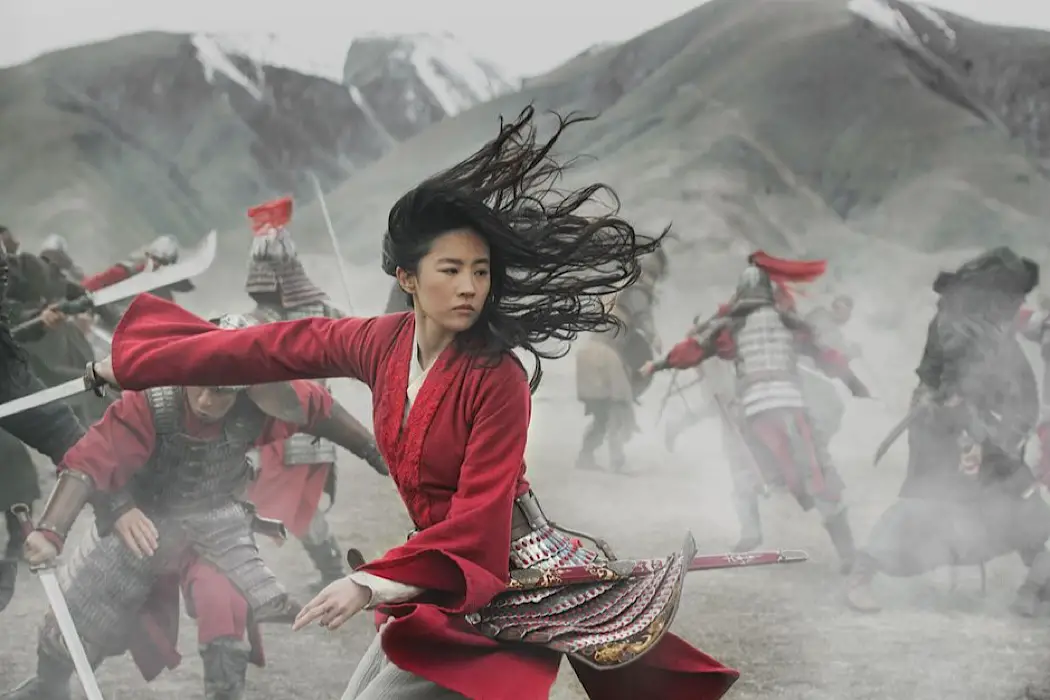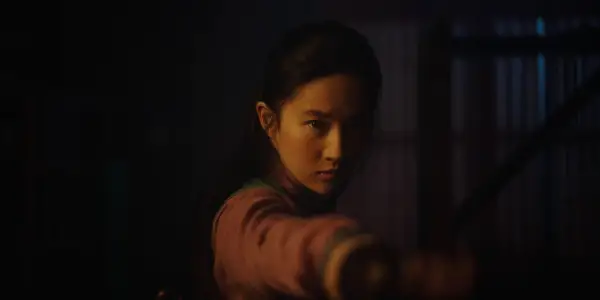MULAN: A Loyal, Brave, And True Re-telling

Kevin L. Lee is an Asian-American critic, producer, screenwriter and…
I find Mulan to be a fascinating case study in terms of reviewing a film based on existing source material. Depending on how you grew up with the story, you could identify it as either the most enduring Chinese folktale of all time or as one of your favorite Disney movies.
Which makes this live-action remake difficult to review.
It’s difficult in the sense that a huge piece of our expectation has already been greatly shaped by something that’s been Westernized. In the 1998 animated film, Mulan goes through a “hero’s journey,” where she rides out into war and trains her way to become a great warrior alongside her comrades – a classic storyline told with a Chinese backdrop. The original Ballad of Mulan, however, depicts her as a woman already skilled in fighting, who has already been taught martial arts, sword combat, and archery, but must hide it due to her social status and, of course, being a woman. In fact, she became a general and led the Chinese army for 12 years, with nobody knowing she was a woman until she revealed the truth herself.
This 2020 Mulan is a brave attempt at retelling the original folktale. It throws out the American comic relief. It throws out the pop songs. Essentially, it removes everything the Western audience has known and loved about Mulan and dares them to find something new to appreciate, and it works.
Familiar Plot, But the Drama Has Changed
Across the countless adaptations, Mulan retains its core premise – Hua Mulan (Liu Yifei) is a brave young woman who takes her father’s place and poses as a man to serve the Chinese army, in the hopes of defeating the Northern Rouran invaders (now led by Bori Khan instead of Shan Yu).

While the 1998 rendition carried on with a story of her befriending her fellow comrades and fighting to save the Emperor at the forefront, this version is far more interested in moments of character and… ahem… self-reflection. With a change in context and thematic agenda, some moments that you have grown up watching may feel glossed over here. It is clear that director Niki Caro is far more interested in the drama than the plot and action, an unavoidable and honorable focus when Mulan’s existing fighting skills are restored.
It is easy to convey the journey of a person training and developing her necessary fighting skills and spirit. It’s much more difficult – and frankly, much more interesting – when the person already has those things, but something else holds her back. With that comes big fundamental changes in the characters.
A Shift in Characters
The side characters we all know and love – Ling, Yao, and Chien-Po – are barely in the film. It’s an admirable but problematic change since the film is largely focused on Mulan and her conscience. In exchange, we get a group of comic relief characters who are too indistinguishable from each other – the only way you can tell who’s who is based on the lines they say from the 1998 film.
Captain Li Shang, on the other hand, sees the most interesting change. The script now divides his role into two separate characters, that of Commander Tung (Donnie Yen) and the young Chen Honghui (Yoson An), further expanding the different types of gender dynamics Mulan faces on her journey. Though Yen doesn’t get much to do in the film, the script gives just enough moments of An to make us want to understand him a bit further.
And then there’s Mulan’s father Hua Zhou, played by the great Tzi Ma. All I can say is thank god the film gives him more scenes with his daughter, allowing us to feel even more of Mulan’s love for her father and her family. It allows for a couple of moments near the end of the film to be felt in a whole new way.
All of these performances are absorbed and internalized by our star, Liu Yifei, who has been my dream casting choice for Mulan ever since I was in middle school. She sells Mulan’s inner turmoil in hiding the truth and being unable to show the world who she is. At the same time, she commands the screen with such elegant and momentous strength.

But the real addition to the story that saves Mulan’s internal struggle from becoming repetitive is the introduction of Xian Lang (Gong Li), a powerful shape-shifting witch, to serve as her foil. The relationship between Mulan and Xian Lang, the two key female players in the plot, is so fascinating I wish more of the film was about them.
Production Value, Action, and Set Pieces
Mulan also benefits from popping on the screen with a dazzling array of colors and attention to detail. The set and costume designs strike a good balance between historically accurate and fantasized like a myth, and all of the outfits and sets do feel worn and lived in – something that I found to be overlooked in the Aladdin remake.
Even with most of the film’s attention set on the human drama, Caro offers just enough of the grand action set pieces that we’ve come to hope for in a live-action Mulan remake. Though the wuxia choreography is never as fluid as Crouching Tiger Hidden Dragon and the epic battle scenes pale in comparison to something like Red Cliff, it is already a pleasant surprise to me that Disney even embraced this direction in the first place.

Overall, the action scenes highlight the admirable production value of the project. It’s currently the most expensive film ever made by a female director, and I believe it shows. Each location is well-realized with its own distinct color aesthetic, and the action that accompanies each location is coherently shot and put together without too much overediting. Personally, though, I would’ve liked a bit more wuxia and a bit less slow motion.
A Damn Good Second Try from Disney
With this much attention to historical detail and dedication to have an all-Asian cast, I almost wanted all of Mulan to be spoken in Mandarin instead. The immersive visuals worked so much that the characters speaking English became an odd but unavoidable drawback.
That’s not all of the film’s problems. Quite a few scenes of the dialogue felt too stiff in their delivery, and I think it’s largely because they feature Chinese actors speaking their secondary language. Jet Li is practically unrecognizable here too, with a voice that I swear is a bad audio dub. Lastly, the pacing and scene transitions do come off as rushed here and there, particularly when characters go through resolutions.
However, when it comes to being the second adaptation of the Chinese folktale from Hollywood, this is a damn good second try. They took one big step closer to what the original legend was about, while still retaining that classic Western celebration of individuality and accepting oneself, and the emotional empowerment still works. When Mulan finally releases her hair and both metaphorically and literally sheds her armor, it’s the most triumphant moment in the film. It’s Wonder Woman crossing No Man’s Land. It’s the lightsaber flying into Rey’s hand. It’s the story embracing the heroine, for the heroine has finally accepted who she is.
Mulan: It’s Not Perfect, But I Support It Wholeheartedly
This film, on paper, is a fundamentally different story from the 1998 version. It may appeal to fewer moviegoers, for the conflict is far more internal than before and the plot is far more throw away than before, but the film succeeds in what it sets out to do.
In the long run, the 1998 version will still outlive this remake, but to me, that’s not important. The important thing is today’s youth now has two distinctly different and emotionally empowering films to grow up with.

It’s funny because the 1998 Mulan is such a beloved classic, even though Disney changed so much of that story. The studio at the time couldn’t even distinguish what’s Chinese and what’s Japanese, especially with the rise of Japanese influence in American pop culture in the late 90s. Mulan was arguably drawn more Japanese than Chinese, and the first act placed her in literal geisha makeup. And of course, there was Mushu, a lovable but clearly American side-character to help keep the story lighthearted and entertaining. These were all “problems” that I’ve accepted a long time ago.
I love the 1998 film. It remains one of my favorite Disney films. But I also wanted it told again. At the same time, I was terrified if it was going to be done wrong or done badly. In the years of dreaming for a live-action Mulan movie, long before the days of Crazy Rich Asians, that one shot has to be a bullseye, or we won’t get another opportunity for another X or so years.
This 2020 Mulan isn’t perfect. I like it enough. But I support it wholeheartedly because it’s more than just a remake. It’s a loyal, brave, and true re-telling of a Chinese ballad that was once successfully Westernized. It proves that stories have reasons to be kept alive and be told time and time again.
Did you see Mulan? What did you think of the film? Share below!
Mulan premiered in the US on March 9, 2020. It was released on Disney+ on September 4, 2020.
Watch Mulan
Does content like this matter to you?
Become a Member and support film journalism. Unlock access to all of Film Inquiry`s great articles. Join a community of like-minded readers who are passionate about cinema - get access to our private members Network, give back to independent filmmakers, and more.
Kevin L. Lee is an Asian-American critic, producer, screenwriter and director based in New York City. A champion of the creative process, Kevin has consulted, written, and produced several short films from development to principal photography to festival premiere. He has over 10 years of marketing and writing experience in film criticism and journalism, ranging from blockbusters to foreign indie films, and has developed a reputation of being “an omnivore of cinema.” He recently finished his MFA in film producing at Columbia University and is currently working in film and TV development for production companies.













